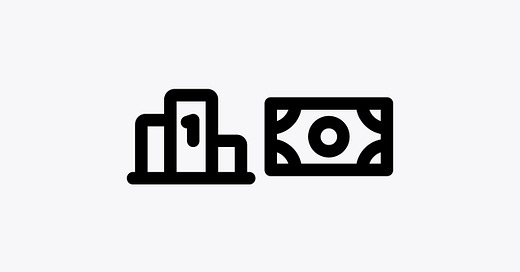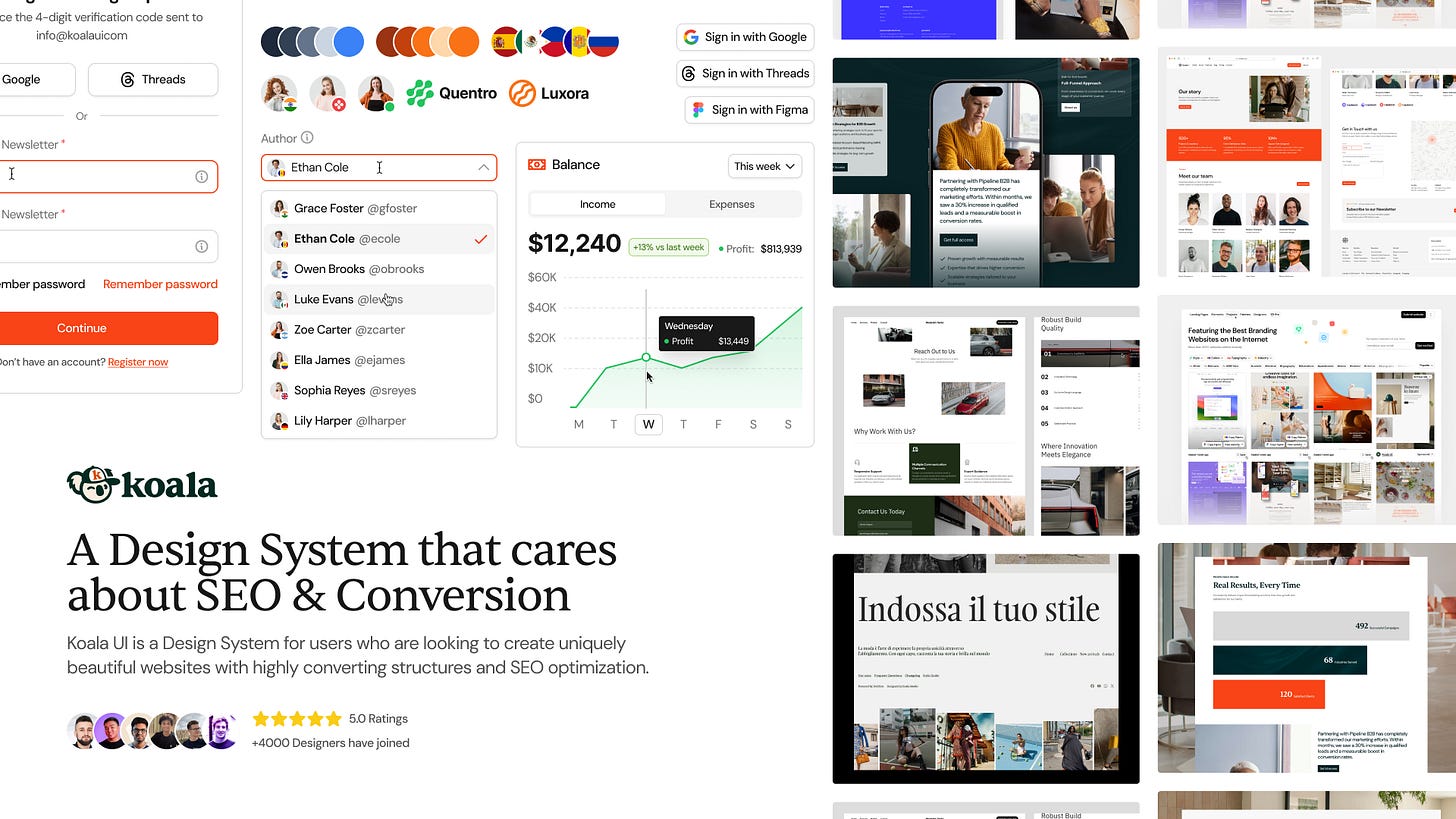🪜 From $500 to $3,000: How I transformed my freelance pricing · The Bunker #124
3 efficient techniques that experience has taught me to raise my prices.
Five years ago, I charged $500 for a landing page.
At the time, I thought it was a good deal. I was excited to land a client and get paid for something I loved doing. But then I did the math…
When the project was finished, I looked back at everything I had actually done:
Multiple client meetings to understand their needs and expectations
Design iterations based on feedback and endless back-and-forth emails
Final revisions that seemed never-ending
Post-launch support, fixing minor issues, and answering questions
Additional tweaks and optimizations I wasn’t even paid for
Total time spent: 30+ hours. My actual hourly rate? $16.
At first, I justified it. I thought, this is just how freelancing works.
But over time, frustration started creeping in. I wasn’t just designing, I was working a full-time job without benefits, stability, or even a proper income.
Why? Because I was inexperienced, and people take advantage of that.
At the beginning, you don’t know how to say no, you're afraid of losing opportunities, and you feel like you have to accept every project that comes your way.
You believe that every client that appears is a unique opportunity you can’t afford to miss.
You lack the confidence to set boundaries and the experience to negotiate better conditions.
Over time, I learned that saying no to clients who don’t value your work is just as important as saying yes to those who do.
That’s when I realized my mistake wasn’t in my design skills. It was in how I positioned and perceived my value.
The client knew that all of this was excessive, but since I wasn’t setting any boundaries or saying anything... they just kept going.
The 3 biggest pricing mistakes freelancers make
Most freelancers price their work the wrong way, and I was no exception.
I followed the same broken pricing models that keep talented designers underpaid and overworked. Here are the 3 biggest mistakes I was making:
1️⃣ Charging hourly rates
This punishes you for being efficient. The better you get, the less you earn. Clients start questioning why something took “so little time,” and suddenly your expertise works against you instead of in your favor.
For example, I always work with my own tool, koalaui.com, which makes me infinitely faster. I don’t sacrifice quality because I’m using a structured library that allows me to work much more efficiently.
Does that mean I should charge less? No. In fact, I should probably charge even more because I’m delivering an outstanding result in half the time.
I’ve saved you time → Therefore money. And improved your outcome.
2️⃣ Flat fees with no strategy
You undercharge because you don’t consider all the hidden costs: time spent on research, revisions, client communication, unexpected technical challenges, and ongoing support.
Every project comes with hidden demands that aren’t accounted for in a simple flat fee.
Without a clear strategy for pricing, these additional tasks pile up, extending project timelines and drastically reducing profitability.
As a result, what initially seemed like a great deal ends up consuming far more of your time and energy than anticipated, leaving you underpaid and overworked.
Something that works well for me is setting a clear number of revisions upfront.
This establishes boundaries between the client and me, ensuring we both know what to expect and preventing excessive, unpaid revisions.
3️⃣ Market-based pricing
You look at what others charge and copy them, assuming that’s the right price.
But here’s the problem: you have no idea why they set that price.
Maybe they’re undercharging because they lack confidence.
Maybe they have a different business model that allows them to charge less. Or maybe they’re overpricing without providing enough value to justify it.
Blindly following market-based pricing is dangerous. If you price yourself too low, you risk attracting clients who don’t value your work and expect endless revisions. If you price too high without a strong value proposition, clients will hesitate, and you’ll struggle to close deals.
Instead, focus on your unique value, experience, and the measurable results you bring to your clients. Your pricing should reflect the transformation you provide, not what others are charging.
Clients don’t pay for your time. They pay for the transformation you create and the value you provide to their business.
High-earning designers don’t sell time. They sell results.
They reframe their work as an investment, not an expense. When you shift your pricing mindset from 'what others charge' to 'what results I deliver,' you position yourself as a premium service provider rather than just another freelancer in a crowded market.
The 3 pricing shifts that changed my career
Once I stopped focusing on time and started focusing on value, everything changed.
Here are the three pricing shifts that took me from $500 projects to $3,000+ projects:
1️⃣ Charge for outcomes, not effort
(Some) Clients don’t care how many hours you work. They care about what they get.
A landing page that increases conversions by 30% isn’t just a design, it’s a business asset that drives revenue.
If a company makes an extra $50,000 a year because of your website, do you think they care whether it took you 5 hours or 50 hours? No, they care about the return on investment.
So instead of selling design as a service, I started selling business growth through design. That mindset shift alone made it easier to charge premium prices.
2️⃣ Use tiered pricing
Most freelancers make the mistake of offering just one price. Instead, I started offering three pricing options:
Basic package – A simple, no-frills solution for those with a limited budget.
Premium package – The best value for money, including strategic design and additional features.
VIP package – Full customization, priority service, and long-term support for those who want the best.
Here’s why this works: Most clients will pick the middle option, making it easier to increase your average project value. Plus, having a high-end option anchors your prices, making your mid-tier package seem like the logical choice.
Even if, in the end, you might end up giving the client some of the features from the highest package, I still recommend detailing all your packages as clearly as possible.
Add compelling elements, such as offering 5 revisions instead of 2, or including support in case the website crashes within two years, among other valuable features.
3️⃣ Raise your prices before you feel ready
I used to wait for “the right time” to raise my prices.
I thought I needed more experience, better skills, or a bigger portfolio. But here’s the truth: If no one is saying, “you’re too expensive,” you’re charging too little.
At the very least, this is the indicator I look for as a signal that it’s time to raise my prices.
Raising prices is uncomfortable at first, but the best clients pay for confidence, expertise, and results, not just your time. The ones who argue over every dollar often demand the most work and cause the most stress.
In fact, I’d say that it is easier to successfully close and complete a $20,000 project than a $2,000 one. This is because the $2,000 project will constantly focus on the money rather than the best possible solution for their product.
Stay away from those who don’t even prioritize the value of their own product.
Price isn’t the problem. Value is.
Sometimes, your price seems high because your perceived value isn’t there yet.
People pay without hesitation when the value of working with you outweighs the cost.
That means your portfolio, testimonials, and positioning all need to clearly communicate the results you deliver.
You need to increase your value so much that it would seem ridiculous not to pay what you're asking for.
Here’s how you can increase your perceived value:
Show proof of results: Case studies, testimonials, and before-and-after comparisons show measurable impact.
Improve your sales pitch: Don’t just sell design, sell how your work drives business growth.
Find a profitable niche: Specializing in a specific industry or problem makes you the go-to expert, not just another designer.
It’s not about charging more. It’s about becoming more valuable.
Focus on how to become more valuable, not how to be more expensive.
From charging $500 to charging $3,000, the difference isn’t skill. It’s how you position your value.
Stop selling design. Start selling business results.
And suddenly, $3,000 feels cheap.
Until next time,
Jordi Espinosa.
✨ This Week’s Sponsor
Koala UI is a Design System built for users who are looking to create uniquely beautiful websites with highly converting structures and SEO optimization.
Get 20% off with code: THEBUNKER20.
If you've ever wondered whether you can make a living through content creation, I’ve got something exciting to share!
I just released my book: From $0 to $10,000 in client projects with only 10,000 followers on Instagram, a journey of how I turned my passion into a profitable business.
🔖 The Bunker Bookmarks
⚡ [FREE] Favourite site for branding inspiration
🖊️ Freelance Notion Bundle · 16 Templates in 1 Pack
🖊️ My portfolio
🖊️ [FREE] Favorite Figma UI Kit
📕 The Ultimate Guide to Choose the Right Typeface · Workbook
🧠 [FREE] Second Brain for Creatives · Notion Template
🧠 [FREE] How to Make a Living from Social Media with Only 10.000 Followers
📕 [FREE] Typography is for everbody™
💖 [FREE] Favorite icon pack.
🤹🏻 My Equipment
✱· Most Productive Designer Mouse
✱· Office chair
✱· Sony A7IV




